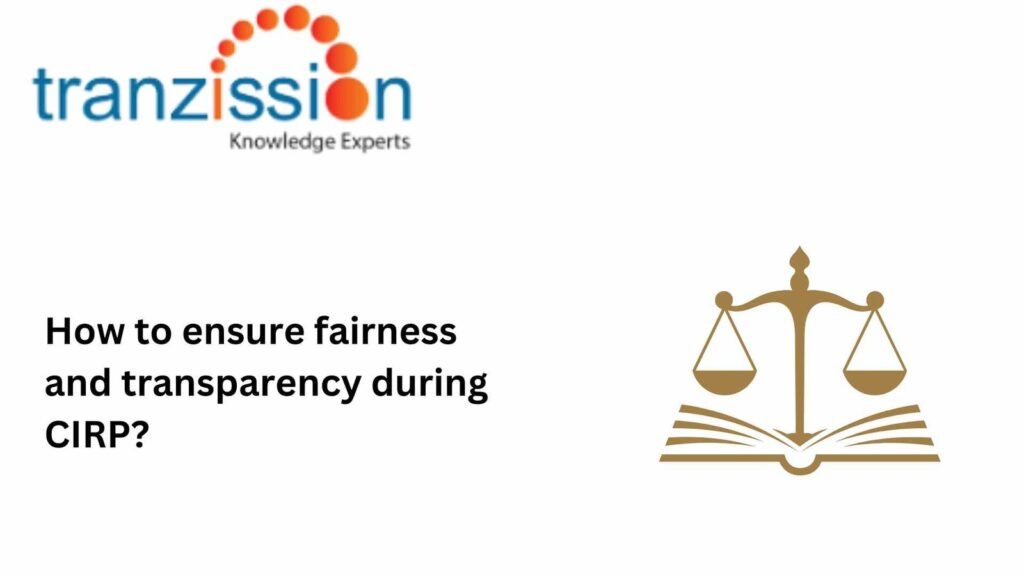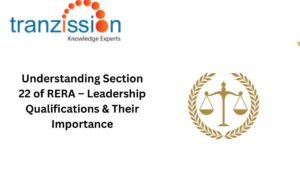
How to ensure fairness and transparency during CIRP?

Table of Contents
The Insolvency and Bankruptcy Code, 2016 (IBC) establishes a time-bound process that ensures fairness and transparency during CIRP in the insolvency process. It is the responsibility of insolvency professionals and the Adjudicating Authorities to ensure fairness and transparency during the corporate insolvency resolution process (CIRP) in the IBC. This allows for a level playing field where everyone can participate in the decision-making process without bias or unfair advantage.
Importance of Fairness and Transparency during CIRP
During insolvency proceedings, all parties involved should have access to the same amount of information as other stakeholders and avoid conflicts between them. The importance of fairness and transparency during CIRP is:
Building Trust Among Stakeholders:
There are multiple stakeholders involved in the insolvency process, including corporate debtors, creditors, insolvency professionals, etc. The IBC aims to balance the interests of all stakeholders. Therefore, establishing fair proceedings enhances creditor confidence and encourages participation in CIRP. By keeping the process transparency during CIRP, the IBC also mitigates conflicts between the stakeholders. Overall, the insolvency framework in India promotes smoother resolutions.
Aligning with IBC Objectives:
According to the Preamble of the IBC, the IBC has a goal to maximize asset value and ensure equitable treatment of all stakeholders. Maintaining transparency during CIRP and accountability during the insolvency process is essential to achieve the objectives of the IBC.
Key Provisions Ensuring Fairness and Transparency
The IBC, rules, and regulations govern the insolvency process and, hence, it is necessary to understand which provisions ensure fairness and transparency during CIRP:
Insolvency and Bankruptcy Code, 2016:
When a company enters CIRP, a public announcement is made to notify of the situation, ensuring transparency and allowing them to participate in the resolution process. The CoC under section 21 comprises all creditors of the company and is responsible for approving the resolution, ensuring all creditors have a voice in the decision-making process. Further, section 29A ensures only credible resolution applicants participate.
CIRP Regulations and Their Role:
The Insolvency and Bankruptcy Board of India (Insolvency Resolution Process for Corporate Persons) Regulations, 2016 (CIRP Regulations) emphasises fairness and transparency by requiring detailed disclosure of information to all stakeholders, including CoC, regarding the financial position of the debtor. It ensures all parties have equal access to crucial data to make informed decisions during the insolvency process. Regulation 36 mandates the preparation of an Information Memorandum to provide complete data to potential applicants.
Recent Amendments to CIRP Regulations
The Discussion Paper of the Insolvency and Bankruptcy Board of India (IBBI), 1st November 2023 proposed enhanced disclosure requirements for resolution professionals and applicants to prevent biases and mandatory recording of deliberations during CoC meetings to enhance accountability.
Judicial Insights on Ensuring Fairness in CIRP
Judicial precedents elaborate on the complexities of understanding and implementing fairness and transparency in CIRP. For instance in Ajay Gupta v. Pramod Kumar Sharma, there were allegations of unfair practices and a lack of transparency during CIRP proceedings. The ruling of the National Company Law Appellate Tribunal (NCLAT) emphasized the need for strict compliance with Section 29A and a level playing field for all resolution applicants. This case highlighted the necessity of resolution professionals to follow due process and avoid conflicts of interest and any deviation from the CIRP framework can lead to annulment of the resolution process.
Challenges to Fairness and Transparency in CIRP
Lack of Complete Disclosure:
Stakeholders may submit inadequate or misleading information in the informational memorandum. This may deter genuine applicants, making it difficult to implement fairness and transparency in CIRP.
Conflicts of Interest:
There are multiple stakeholders when a company becomes insolvent. Each stakeholder has different amounts of debt that the company needs to repay at the end of the insolvency or liquidation process, meaning there will be conflicts of interest. To avoid such disputes, resolution professionals or the CoC also conflicts that undermine fairness.
Procedural Delays:
Unnecessary delays that occur during the CIRP are because of the complexity of legal procedures, such as excessive litigation, and lack of coordination between stakeholders. These delays create opportunities for manipulation and reduce asset value.
Read more : The Doctrine of Clean Hands in Insolvency Law
Strategies to Enhance Fairness and Transparency
To effectively implement fairness and transparency at every stage of the CIRP process, certain strategies can be adopted:
Strengthening the Role of Resolution Professionals:
Resolution professionals have the main role of ensuring transparency in insolvency proceedings. However, resolution professionals and other stakeholders may have conflicts of their own on legal or financial matters in insolvency cases. Imposing stricter standards for independence and accountability for their actions is needed. The IBBI should also mandate training programs on ethical conduct and regulatory compliance.
Improving Information Disclosure:
There are several documents and forms that need to be submitted and filed throughout insolvency proceedings. To ensure that each document or form is submitted, reflecting the financial situation of the distressed company, developing a standardized format for the Information Memorandum is crucial.
Ensuring Neutral Decision-Making in the CoC:
The members of the CoC often may have conflicts regarding the resolution plan and future steps of the company. Therefore, third-party audits may help to oversee CoC decisions and encourage diverse representation to prevent dominance by certain creditors.
Leveraging Digital Tools:
Insolvency professionals and other stakeholders can adopt digital tools to make the CIRP more efficient and transparent. Blockchain technology can be utilised for tamper-proof documentation of the CIRP process and automating routine tasks to reduce human bias. Technology, such as artificial technology or data analytics, can be leveraged for secure and transparent data sharing.
Read more : Impact of IBC on Foreign Direct Investment
Practical Recommendations for Stakeholders
For Resolution Professionals:
Resolution professionals need to maintain neutrality while prioritising compliance over expediency. By leveraging technology and ensuring all stakeholders submit the necessary information as per the prescribed time under the IBC. Thereby, they ensure timely and complete disclosures.
For the Committee of Creditors:
To ensure fairness and transparency for the CIRP, it is recommended to promote collective decision-making rather than individual dominance. It is also important for the CoC members to adhere to procedural timelines to avoid unnecessary delays.
For Regulators:
The IBBI is recommended to periodically review CIRP regulations to address emerging challenges and penalize stakeholders engaging in unfair practices.
Conclusion
Ensuring fairness and transparency in CIRP is pivotal for the success of India’s insolvency framework. All stakeholders involved in the insolvency process, creditors, debtors, and the insolvency professional, should have access to complete and accurate information about the company’s financial situation. The IBC ultimately aims for an equitable distribution of assets among creditors based on their claims. To achieve absolute fairness and transparency in the insolvency process it is crucial to establish proactive measures, regulatory amendments, and stakeholder accountability.
FAQs
1. What is CIRP?
The corporate insolvency resolution process (CIRP) is a recovery mechanism for creditors of a corporate debtor, aiming to resolve a corporate debtor’s insolvency.
2. Why is transparency crucial in CIRP?
Transparency is crucial in CIRP because it ensures all stakeholders involved have access to complete and accurate information about the company’s financial situation. This allows for fair and informed decision-making during the resolution process.
3. How can conflicts of interest in CIRP be avoided?
To avoid conflicts of interest there should be strict disclosure requirements for insolvency professionals, clear guidelines on related party transactions, independent oversight mechanisms, and adherence to the ethical code established by the IBBI.





